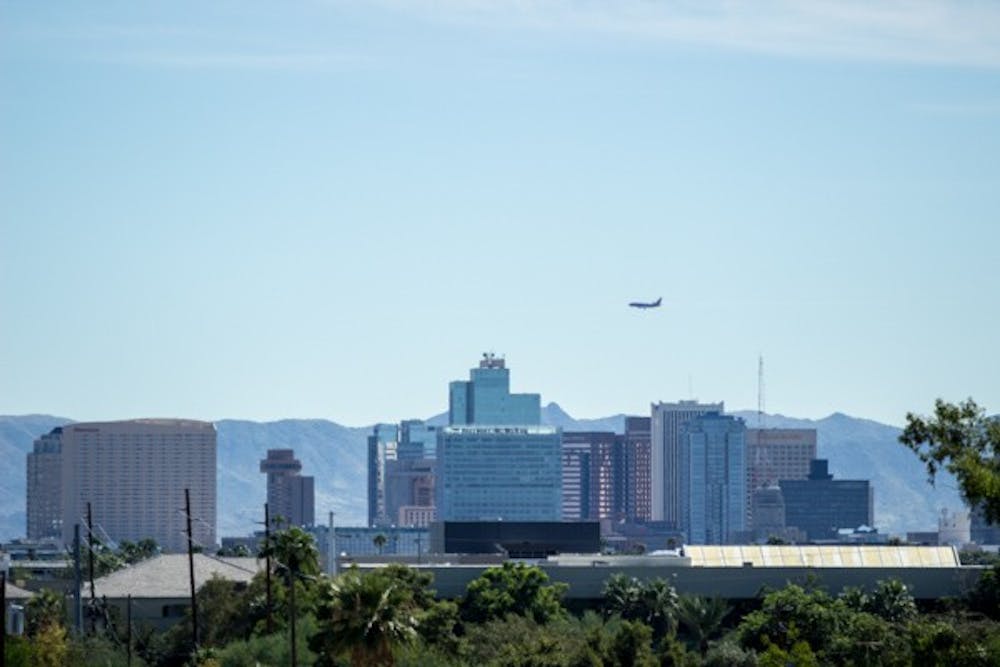 The Center for Integrated Solutions to Climate Challenges at ASU released a report in July about the effectiveness of strategies to lower the urban heat island effect. The report showed that Phoenix's use of urban forestry and cool roofs have helped reduce temperatures in the area. (Photo by Alexis Macklin)
The Center for Integrated Solutions to Climate Challenges at ASU released a report in July about the effectiveness of strategies to lower the urban heat island effect. The report showed that Phoenix's use of urban forestry and cool roofs have helped reduce temperatures in the area. (Photo by Alexis Macklin)Summers are hotter in Phoenix than they are in any other city in the U.S., according to a 2013 USA Today report, but new data suggests that steps taken by Phoenix to combat this problem have been successful.
Nancy Selover, Arizona State Climatologist and professor at ASU’s School of Geographical Sciences and Urban Planning, said extreme heat is a serious problem in Phoenix that needs be addressed.
“There have been deaths from extreme temperatures all around the country,” she said. “In the Midwest, it’s from extreme cold, but in Phoenix, the deaths are caused by extreme heat. If we can keep the heat down, hopefully we can save some lives.”
Scientists believe the city’s rising temperatures should be partially credited to a phenomenon called the urban heat island effect, by which temperatures in highly urbanized areas increase drastically due to the absorption and slow radiation of solar heat from concrete.
The Center for Integrated Solutions to Climate Challenges at ASU released a report in July that quantified the efficacy of two prominent strategies that Phoenix has used to combat the urban heat island effect: urban forestry and cool roofs.
The findings published in the July heat mitigation assessment proved that measures taken by Phoenix through the Phoenix Cool Roofs and Tree and Shade Master Plan are reducing this effect.
The study found that increasing tree shade in a neighborhood from 10 percent to 29 percent could lower temperatures by 4.3 degrees Fahrenheit.
The findings of the study become even more impressive when urban forestry is paired with “cool roofing” — white, reflective roof surfaces — in a particular area.
Through a number of municipally funded projects and residential outreach programs, Phoenix has tried to increase the presence of both trees and cool roofs within its borders.
Selover said the facts presented by the report would likely encourage more government spending on these heat mitigation strategies.
“They’re not just going to spend a lot of money when they don’t know how effective it’s going to be,” she said.
She said she thought the report was positive reinforcement that would “keep Phoenix going and bringing other cities with them.”
City of Phoenix Environmental Program Manager Joe Gibbs said the city received a Bloomberg Philanthropies Cities of Service grant for $65,000 in January to cover 70,000 square feet of city rooftops with the cool roof coating over a one-year period.
Part of the grant went toward recruiting, coordinating and overseeing a 100-volunteer workforce that applied the “cool roof” technology to buildings around the city, he said.
He claimed the volunteers’ efforts paid off, and the roof coating had amazing effects on the temperature inside of buildings.
“In some cases, we did a ‘before and after’ of energy use (in the buildings enhanced with cool roof technology) from 12 months before the application to 12 months after the application, and we saw as much as a 30 percent reduction in energy use,” Gibbs said.
However, the July heat mitigation assessment report said the cool roof technology was ineffective unless used with urban forestry.
Richard Adkins is the Forestry Director for the City of Phoenix, and he said trees are the key to combating the urban heat island effect.
“All civilizations have grown with trees,” Adkins said. “Trees are part, basically, of our heritage. They’re how we’ve developed — we get lots of products from trees; we get lots of benefits from trees.
Among the benefits he listed were trees’ effect on air pollution, on soil erosion and on aesthetics, but he said their greatest attribute is the shade they provide.
Heat absorption by plants is also different from heat absorption by rocks and concrete because heat is not retained by plants and reflected back into the environment.
Adkins said Encanto Park and Murphy Bridle Path in central Phoenix are prime examples of effective urban forestry, and he said Civic Space Park in downtown Phoenix was a good example of urban forestry combining with modern architecture to create a shade-rich environment.
“Back in the ‘20s, Phoenix was known as the Valley of Gardens and Trees," he said. "There were trees all over the place, lining the canals here. Trees were a part of our infrastructure and our daily life. They weren’t just something over in the backyard that provided us with a little bit of shade and that we didn’t care about.”
Adkins said that, nowadays, people tend to think of trees as a burden. He said he often hears people complain about how tree debris clogs their pools and about the mess they leave in the streets after storms.
But he said this mindset is something the city will work to change by educating the public about urban forestry benefits and by setting a “good example” on municipal land.
He said the city’s goal is to reach 25 percent urban tree shade coverage before 2030.
“I look forward to the challenge,” he said.
Reach the reporter at megann.phillips@asu.edu or follow her on Twitter @megannphillips
Like The State Press on Facebook and follow @statepress on Twitter.




